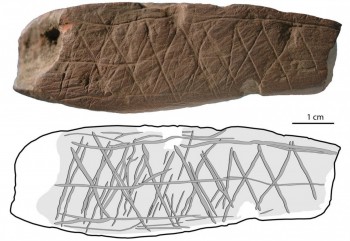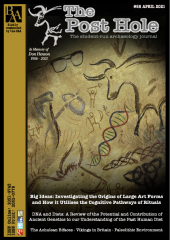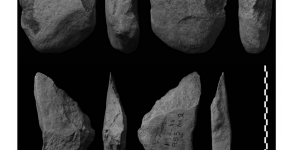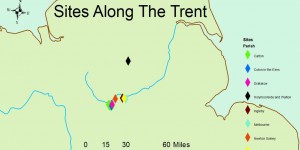Introduction
This article investigates the significance of manipulating scale in the creation of European representational art and whether its appearance in the human repertoire signifies a step forward in cognitive and social development. It shall be looked at predominantly from a cognitive evolutionary perspective; analysing how large-scale art feeds off the cognitive processes involved in ritualistic behaviour to synthesise emotive physiological responses in the viewer(s). Alongside this, I will propose that the origin of the manipulation of scale in art was developed as a mechanism to aid understanding of cosmological (progressing to ideological) ideas through embodied cognition and metaphor.
Background
The investigation into pre- and proto-historic art can be exploited to a new breadth when researching the discipline through the lens of visual psychology. This style of investigation has been applied to archaeology from an evolutionary perspective by Derek Hodgson, deepening research into the nature of cognitive development through the gradual complexity of art forms (Hodgson 2000). Art first appears in the archaeological record as linear markings on a portable rock in Blombos Cave, South Africa, c.75,000 BP (figure 1) (Henshilwood et al. 2009) but developed to incorporate patterns and geometric shapes, reaching the refined representational art we see on the walls of the most famous caves in archaeology by c.17,000 BP (e.g. Lascaux) (see Aujoulat 2005, 57 and Pettitt 2015 for alternative Chauvet dates).

When investigating the evolution of art, Hodgson (2000, 6) highlights the significance of representational art as an indicator to cognitive and cultural development: “it is only at this point that two-dimensional picture-making becomes a powerful vehicle for the transmission of ideas and the prevailing cultural norms”. This article will adapt Hodgson’s claims to investigate the important origins of oversized art: art that is beyond the usual limits of scale variants seen in similar contexts and time periods.
Colossal statutory and oversized building complexes are the most impressive features of ancient civilisations, inviting tourism and immense fieldwork. But from art’s humble beginnings to the portrayal of great rulers of vast control (both socio-politically and psychologically) and power in ancient civilisations, one must take into consideration the several challenging cognitive obstacles our ancestors had to overcome in developing the manipulation of art’s size. Representational art, as Hodgson (2000, 6) made clear, has huge implications for understanding brain and social development, with the first clear representational art on portable 3D objects existing from 42,000 BP (Higham, et al. 2012). However, representational art on a 2D surface (in particular cave walls) developed about 8,000 years before the scale variants associated with Lascaux in the Solutrean (18,000 BP) appeared (Aujoulat, 2005, 57). .
Investigation
The main cognitive obstacles scale posed was how to understand its initial implications and importance. However, mentally navigating the creation of Large Scale Art (LSA) when working on it piece-by-piece also entails its own challenges. It is only the former question I shall tackle in this article and to do this I propose that one must appreciate two things: 1) how art can evoke emotive responses; and 2) the parallels between the psychological effects of ritual and that of LSA.
How art can evoke emotive responses has not been directly researched in the current academic literature, thus proving difficult to support in recorded experimentation. However, it is sensible to identify what emotive triggers are set in the mind that relate to a visual stimulus. The most applicable to this article is awe and it is, by its own definition, an emotive response in close contingence with feelings of reverence, fear, and admiration – all resonate with a powerful, grand or immersive/overwhelming stimulus. As we shall see, awe and its accompanying heightened emotions require a stimulus of adequate strength, one that can be created with scale. To emphasise this point, an extract from Shelley’s poem Ozymandias (1818) is below. This poem was thought to have been inspired by a fragment of a statue of the Ancient Egyptian pharaoh Ramesses II which was acquired by the British Museum shortly before this was published (Sarikas, 2019) and would further support the effects LSA has on its audience:
“...My name is Ozymandias, King of Kings;
Look on my Works, ye Mighty, and despair!
Nothing beside remains. Round the decay
Of that colossal Wreck, boundless and bare
The lone and level sands stretch far away.”
In this poem, the vastness of the sculpture itself, along with its destruction and inscribed words, perfectly evokes awe in the reader both for the grandeur of its size and for its epic collapse. In this poem, Shelley both appreciates and adapts the undeniable emotive power of LSA as a force in his own work.
Scale and its accompanying awe requires the appreciation of size relative to that of your own body. Therefore, one can attribute self-transcendence as a salient feature of awe. Along with LSA, self-transcendence (a state of mind that is characterised by thoughts extending beyond one’s self) and awe have been observed (and better-documented) in ritual behaviour, linking both rituals and LSA together for the second premise (see below).
Hodgson et al. (2017) applied psychological analysis to ritual behaviour in an investigation that studied the effects of rituals on a cognitive level in both participant and viewer. Below is a table that dissects the different psychological dynamics of ritual activity:
.jpeg?itok=s6WDfB2P)
We can see four points that characterise ritual behaviour along with their respective characteristics. It is clear that the process of ‘Meaning creation and transference’ overlaps with characteristics that have previously been noted in the psychological importance to LSA: self-transcendence and its relationship with symbols of control and power (norm-consistency) (Levenson et al 2019). Moreover, LSA is an immersive experience, manipulating attention biases which relate to the first point on the table (Hodgson, et al 2017, 3). These two aspects of rituals are evidently linked to LSA through use of the same cognitive network established with the developing mind. Although art in any form in the archaeological record is often viewed to be concomitant with ritual, ritualistic behaviour is evident before large scale art in the archaeological record (bones of 30 hominin individuals from Atapuerca cave at least 300,000 years old have been widely accepted as the first evidence of ritual) (Greenspan, 2006). This means the latter must follow the pathways to emotive responses laid down by the former. As Hodgson (Hodgson et al. 2017, 12) points out, rituals enhance the ‘alignment of physiological and emotional states among participants’. Through enlarged scale, art can replicate such states simply by reaching out to a wider simultaneous audience as well as cognitive embodiment (discussed below).
The theory of cognitive embodiment was put forward by two linguistic psychologists in a book called Metaphors We Live By (Lakoff & Johnson 1980) and proposes the idea that one’s physical environment influences mental state. This is the idea that metaphors are intrinsic in understanding abstract thought through the use of language pertaining to physical phenomena (e.g not understanding something is phrased ‘gone over my head’). This has major implications for how we view art; highlighted by Summerville (2018, 20) in The Missouri Review, observing that art made on a big scale prompts us to actually think bigger. Through this, it can be argued that a mental state in the observer pertaining to bigger, more cosmological, less material ideas or narratives can be produced through the powerful visual stimuli of LSA. This would explain why art (especially LSA) is often viewed in contingence with ritual behaviour, where communal acts deliberately push for participants to think about ideas bigger than the self, linking back to self-transcendence. Even the word bigger in this context is a metaphor that is used to describe ideas of wider beliefs.
Discussion
The manipulation of scale in creating large pieces of art and how it affects the observer is an embodiment of the base aims of ritual: condensing the mechanisms to evoke thoughts both emotive and self-transcendent to a static frame. Therefore, through scale art can absorb ritualistic qualities, making it a highly charged and infinitely recyclable means of storing stimuli that evokes ritual-like responses. I argue that this makes LSA a powerful ideological tool for influencing large groups of people; building into a monumental object or sight an overt ‘meaning’ enforces culturally specific, cosmological ideas.
Although Lascaux hosts the largest piece of art in the Upper Palaeolithic; a painted cow, over 5.5 m in length (figure 3) (Lawson 2012, 349), it seems that the exploitation of the psychological effect of LSA was the most intense at the rise of early urban civilisation (Levenson 2019). I argue that statutory and architecture was the predominant focus of artistic output, redirecting scale from a 2D to 3D format. This shift in subject matter, in my opinion, may have been in contingence with the dramatic change in ideology and control associated with urbanism and distributed labour, creating the necessity of constant norm-consistency through powerful art forms endowed only to the people and institutions linked to the power or administrative element of a large urban settlement or ‘state’ (figure 4).
.jpeg?itok=BKcujMVu)
.jpeg?itok=rOvWVXmb)
Conclusion
To conclude, scale is a dimension of artistic output that must be looked at further from an archaeological as well as psychological standpoint. Its unique influence on the physiology of the viewer is made possible by the construction of cognitive processes originally laid down in response to ritual behaviour, revolutionising how cosmological thought can be transmitted.





![Figure 1 ref: A, Lancaster. (nd.) Early Medieval Wales. Available at: viking-5-wales-vikings-on-the-coast.jpg [accessed 17/02]](https://www.theposthole.org/sites/theposthole.org/files/styles/article_thumb/public/articles/506/Figure%201%20%281%29.jpg?itok=22FvdRE7)


